
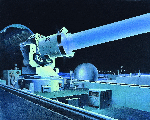
SOVIET GROUND-BASED LASER - Edward L. Cooper, 1986
The Soviet Strategic Defense Program involved extensive research on advanced technologies in the 1980s. The USSR already had ground-based lasers, conceptually illustrated here, capable of interfering with some US satellites.
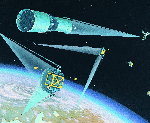
SOVIET SPACE-BASED STRATEGIC DEFENSES - Ronald C. Wittmann, 1987
While publicly opposed to the US Strategic Defense Initiative, the Soviet Union forged ahead with research and development of land-, air-, and space-based ballistic missile defenses. The Soviets had already deployed and tested ground-based lasers.

SOVIET SS-18 MOD 5 INTERCONTINENTAL BALLISTIC MISSILE - Ronald C. Wittmann, 1989
The silo-launched SS-18 Mod 5 was the core of the Soviet Union's modernized ICBM arsenal in the 1980's. The SS-18 featured hard-target-kill capability and ten nuclear warheads on each missile. The Soviets converted silos to replace the older version SS-18 Satan with the MOD 5.
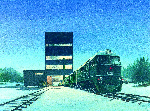
SOVIET RAIL-MOBILE SS-24 MOD 1 INTERCONTINENTAL BALLISTIC MISSILE -
Edward L. Cooper, 1988
The accuracy and survivability of the rail-mobile SS-24 deployed in the 1980's significantly increased the lethality of the USSR's intercontinental ballistic missile force. This missile could be deployed throughout the Soviet Union.

SOVIET SS-12B GIANT AIR DEFENSE SYSTEM - Ronald C. Wittmann, 1989 The SA-12B, developed in the 1980s, was an accurate and long range air defense system for use against aircraft, some stand-off command and control platforms, and possibly some types of cruise and ballistic missiles.
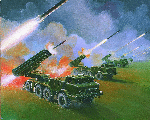
SOVIET BM-27 MULTIPLE ROCKET LAUNCHER - Edward L. Cooper, 1986
The Soviet 16-tube, 220-mm BM-27 multiple rocket launcher was capable of firing high-explosive conventional rounds, scattering mines, and delivering chemical warheads as far as 40 kilometers. In the 1980s, it was widely used to provide long-range fire support to Soviet forces in Afghanistan.
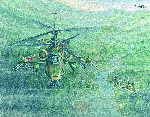
SOVIET HOKUM AND HAVOC ATTACK HELICOPTERS - Brian W. McMullin, 1987
The new HOKUM attack helicopter, flight-tested in the late 1980s, gave the Soviets a significant rotary-wing, air-to-air combat capability for which no Western counterpart existed. Development of the HOKUM and HAVOC (lower right) added to the serious Soviet conventional threat.
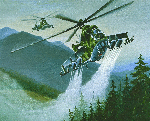
SOVIET MI-24 HIND DELIVERING CHEMICAL SPRAY - Edward L. Cooper, 1986
The USSR maintained the world's largest stockpile of chemical warfare agents in the 1980s. Virtually all conventional systems used by the Soviets--mortars, artillery pieces, helicopters such as these Mi-24 HINDs, aircraft, and long-range tactical missiles--could deliver chemical munitions.
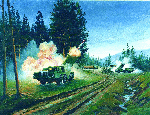
SOVIET 280-MM MULTIPLE ROCKET LAUNCHER - Edward L. Cooper, 1988
The large 280-mm multiple rocket launcher developed by the Soviets in the 1980s was capable of laying down a broad field of fire, threatening armored vehicles, infantry, airfields, and rear service areas.
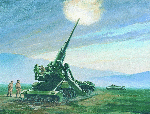
SOVIET 203-MM 2S7 SELF-PROPELLED GUN - Edward L. Cooper, 1987
The 203-mm 2S7 self-propelled gun developed in the 1980's could fire nuclear and conventional rounds to a range of at least 30 kilometers.
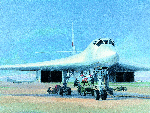
SOVIET BLACKJACK LOADING AS-16 MISSILES - Edward L. Cooper, 1987
AS-16 nuclear missiles carried in the rotary launchers aboard the BLACKJACK strategic bomber in the 1980s were a threat against theater and intercontinental targets. The BLACKJACK bomber entered the Soviet operational inventory in 1988. The AS-16 was a new short range, nuclear armed, air to surface missile.
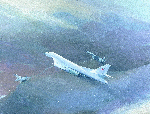
SOVIET BLACKJACK BOMBER WITH ESCORTS - Richard J. Terry, 1988
The introduction of the BLACKJACK intercontinental bomber in the late 1980s made the third leg of the Soviet strategic triad far more robust. The BACKFIRE bomber could perform various missions, including nuclear strike, conventional attack, antiship strike, and reconnaissance. Two MiG-29 FULCRUMS escort this bomber.
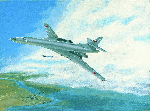
SOVIET BLACKJACK BOMBER FIRING AS-15 MISSILE - Brian W. McMullin, 1987
The BLACKJACK bomber, developed in the 1980s, could carry nuclear-armed AS-15 cruise missiles for its strike and reconnaissance role in a nuclear war. The new BLACKJACK and the AS-15 long-range, air-launched cruise missile significantly increased the Soviet bomber force's weapons delivery capability and survivability.

SOVIET MAINSTAY AWACS AIRCRAFT WITH ESCORT - Brian W. McMullin, 1987
The MAINSTAY airborne warning and control system (AWACS), deployed in the 1980s, provided the Soviet Air Forces with a battle management capability for their new FLANKER and FULCRUM (pictured here) aircraft. An effective AWACS capability was essential for the Soviet drive for theater air superiority over NATO.
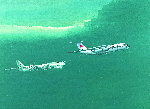
SOVIET MIDAS TANKER REFUELING BEAR BOMBER - Richard J. Terry, 1988
The MIDAS tanker aircraft, which became operational in 1987, was used to support strategic bombers such as the BEAR H (pictured here) and possibly tactical and air defense aircraft. In peacetime, in-flight refueling extended the Soviets' reach from their homeland.
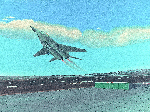
SOVIET FULCRUM TESTED FOR AIRCRAFT CARRIER USE - Ronald C. Wittmann,
In the 1980's, the Soviets developed fixed-wing aircraft for their new conventional aircraft carriers. The MiG-29 FULCRUM and other aircraft were evaluated for ramp-assisted takeoff at Saki naval airfield on the Crimean Peninsula.
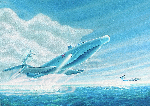
SOVIET WING-IN-GROUND EFFECT AIRCRAFT - Brian W. McMullin, 1988
During the 1980s, the Soviets continued testing various wing-in-ground effect vehicles for use in coastal defense and amphibious operations. The ORLAN-Class, seen here, takes advantage of the increased aerodynamic lift that occurs when a wing operates near the surface. This greatly increases the craft's ability to carry heavy loads over long distances, especially over water, making it well-suited for amphibious warfare.
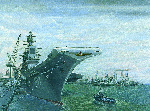
SOVIET TBILISI-CLASS CARRIER AT NIKOLAYEV - Brian W. McMullin, 1987
The lead ship of the USSR's 65,000-metric ton TBILISI-class aircraft carriers being fitted out in the late 1980s in Nikolayev Shipyard. This carrier marked an evolutionary advance in naval capabilities over 37,100-metric ton KIEV-Class carriers then operating with the Soviet fleet.
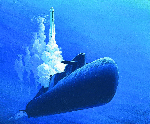
SOVIET DELTA SUBMARINE FIRING SS-N-18 MISSILES - Edward L. Cooper, 1987
A Soviet DELTA III nuclear powered ballistic missile submarine firing SS-N-18 missiles. The DELTA III submarine was 155 meters long, had 16 missile firing tubes, and carried SS-N-18 nuclear missiles.

SOVIET BALLISTIC MISSILE SUBMARINE BASE - Brian W. McMullin, 1986
The USSR's strategic nuclear forces included a growing number of new TYPHOON-class
and DELTA IV-class strategic ballistic missile submarines deployed in the 1980s.
These advanced submarines, fitted with the latest generations of nuclear missiles,
could operate from bases with tunnels for protection.